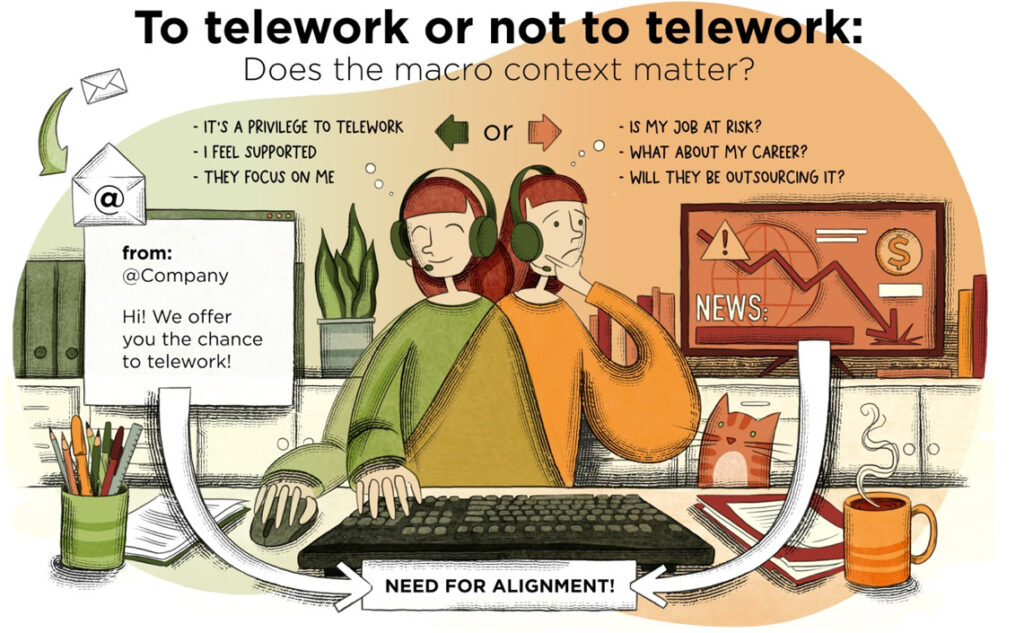Employees’ interpretations of telework can be contradictory, with some observing it as an incentive and a sign of organisational support and others seeing it as a threat to their jobs and career prospects. Managers’ decision to keep telework as a standard practice or to drop it sends different signals for employees to interpret depending on their particular context. Almudena Cañibano and Argyro Avgoustaki write that factors beyond the organisation, such as labour market conditions, play a key role in employees’ interpretation of telework as a potential threat.

Almudena Cañibano
Associate Professor of Management at ESCP Business School

Argyro Avgoustaki
Professor of Management at ESCP Business School
Telework is generally seen as a perk for employees because it can, for example, enable more autonomy, allow people to better balance work and family life and reduce commuting time. However, not all employees agree on this rosy understanding, which often depends on the type of work they perform.
In our recent publication, we show that employees’ interpretations of telework can be contradictory, with some observing telework as an incentive and a sign of organisational support and others seeing it as a threat to their jobs and career prospects.
Is telework a perk or a threat for employees?
This may come as a shock for many organisations who often implement telework to show support to their employees and satisfy their demands. Indeed, after the Covid-19 pandemic, this type of work arrangement seems to have become a “must have” to attract young talent in high demand.
So, why may certain employees interpret the practice as a risk rather than a perk? Our research suggests that, to answer this question, we need to look beyond the organisation, understand the context in which the practice is implemented and look for the existence of what we call external fit: there needs to be alignment between the signals that organisations send to employees through their HR practices and their external environment.

Analysing interviews about telework that took place during the financial crisis of 2008, we found that the macro-level environment plays a key role in employees interpreting telework as a potential threat. The crisis was a repeated and unprompted discussion topic, with workers describing telework as embedded in “these times”, “this environment”, or “this awful context”.
Because of the uncertain context, instead of seeing telework as a sign of their firm’s support, many described it as an unnecessary risk which would make them less visible to their managers and colleagues, potentially endangering their careers and jobs. In general, those employees who saw telework as a perk asked to participate in the programme and were teleworking. On the contrary, those who saw telework as a threat either rejected the practice – they did not telework at all – or did so only occasionally to ensure they were visible in the office.
Same HR practice, different interpretations
This is an important finding for HR practitioners because it underlines that the meaning of HR practices, such as telework, is not predetermined, but continually configured socially, considering events that go beyond the firm’s boundaries. The same HR practice may be interpreted very differently in different contexts.
For example, in a highly dynamic labour market, in which companies rival for talent, providing learning opportunities or attractive reward packages is likely to be interpreted less as a sign of organisational support than it would in a slow market in which employees have less chances of finding an alternative job. Offering private healthcare to workers in contexts with strong institutionalised and protective welfare systems may be seen as more supportive than providing healthcare where workers would not be covered otherwise.
Regulations or labour market conditions are all important contextual elements that may shift people’s understandings of HR practices. Yet such macro-level factors are rarely analysed in depth by HR management teams when designing new policies.
Teleworking became a practice of survival rather than an incentive for employees.
Going back to telework, workers’ understanding of the practice before the pandemic, in April 2020, and nowadays are likely very different. While prior to Covid-19, telework may have been seen by many as a sign of support for employee well-being, at the beginning of the pandemic that understanding generally faded. The restrictions imposed by governments made it so that, in many places, there was no other option for work to continue. Teleworking became a practice of survival rather than an incentive for employees.
Nowadays, as restrictions disappear, organisations can make the choice to keep telework as a standard practice or to drop it. This decision will send different signals for employees to interpret depending on their particular context (including their country’s legal framework and historic background, the strength of unions and labour institutions, their industry’s competitive dynamics, etc.).
So what can managers do? Our work suggests the need to strive for external fit, which we define as the ‘alignment between the signals that organisations send to employees through their HR practices and their external environment’. Good external fit means that the messages that HR practices send are in line and consistent with the messages embedded in the organisation’s environment.
The need for HR to be attentive
While HR practitioners and managers can manage the signals they send, they are not in control of the environment. Therefore, they are not able to determine how such signals are interpreted. To achieve external fit, in designing their practices, firms need to thoroughly analyse their environment over time because an interpretation emerging under conditions of economic growth or stability may be distinct to one emerging in times of crisis.
Given the current context of rapid change and recurrent turbulence, a practice that takes months or even years to be designed, implemented, and disseminated, may unfold in a context that is substantially different to the one in which it was conceived. In this sense, HR must be attentive enough to observe emerging understandings and react to them accordingly. Our ongoing research on how organisations are “reinventing work” and how evolving practices affect workers’ experiences, strives to provide further guidance for managers and HR practitioners on these challenging issues.
This article was originally published by LSE Business Review under the Creative Commons licence CC BY-NC-ND 2.0.
License and Republishing
The Choice - Republishing rules
We publish under a Creative Commons license with the following characteristics Attribution/Sharealike.
- You may not make any changes to the articles published on our site, except for dates, locations (according to the news, if necessary), and your editorial policy. The content must be reproduced and represented by the licensee as published by The Choice, without any cuts, additions, insertions, reductions, alterations or any other modifications.If changes are planned in the text, they must be made in agreement with the author before publication.
- Please make sure to cite the authors of the articles, ideally at the beginning of your republication.
- It is mandatory to cite The Choice and include a link to its homepage or the URL of thearticle. Insertion of The Choice’s logo is highly recommended.
- The sale of our articles in a separate way, in their entirety or in extracts, is not allowed , but you can publish them on pages including advertisements.
- Please request permission before republishing any of the images or pictures contained in our articles. Some of them are not available for republishing without authorization and payment. Please check the terms available in the image caption. However, it is possible to remove images or pictures used by The Choice or replace them with your own.
- Systematic and/or complete republication of the articles and content available on The Choice is prohibited.
- Republishing The Choice articles on a site whose access is entirely available by payment or by subscription is prohibited.
- For websites where access to digital content is restricted by a paywall, republication of The Choice articles, in their entirety, must be on the open access portion of those sites.
- The Choice reserves the right to enter into separate written agreements for the republication of its articles, under the non-exclusive Creative Commons licenses and with the permission of the authors. Please contact The Choice if you are interested at contact@the-choice.org.
Individual cases
Extracts: It is recommended that after republishing the first few lines or a paragraph of an article, you indicate "The entire article is available on ESCP’s media, The Choice" with a link to the article.
Citations: Citations of articles written by authors from The Choice should include a link to the URL of the authors’ article.
Translations: Translations may be considered modifications under The Choice's Creative Commons license, therefore these are not permitted without the approval of the article's author.
Modifications: Modifications are not permitted under the Creative Commons license of The Choice. However, authors may be contacted for authorization, prior to any publication, where a modification is planned. Without express consent, The Choice is not bound by any changes made to its content when republished.
Authorized connections / copyright assignment forms: Their use is not necessary as long as the republishing rules of this article are respected.
Print: The Choice articles can be republished according to the rules mentioned above, without the need to include the view counter and links in a printed version.
If you choose this option, please send an image of the republished article to The Choice team so that the author can review it.
Podcasts and videos: Videos and podcasts whose copyrights belong to The Choice are also under a Creative Commons license. Therefore, the same republishing rules apply to them.





